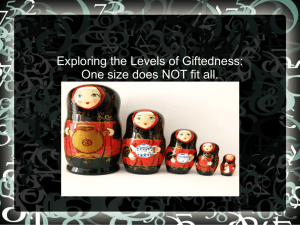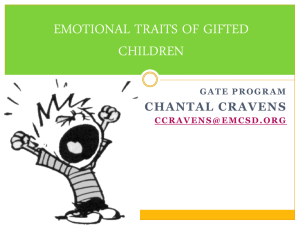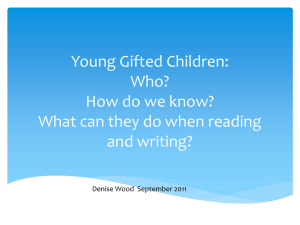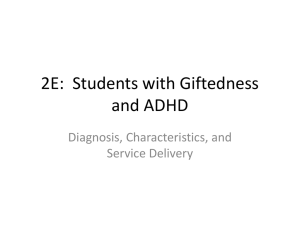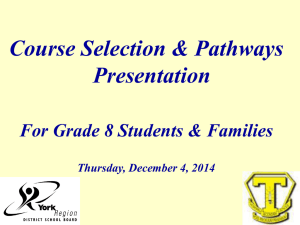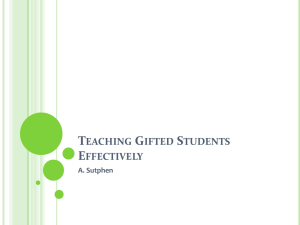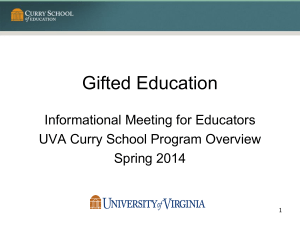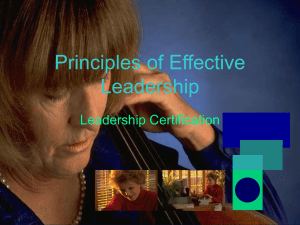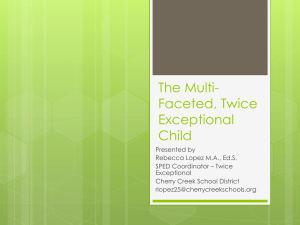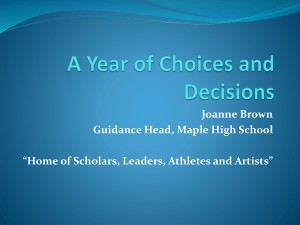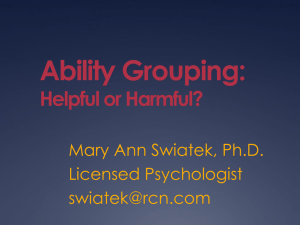Understanding-and-supporting-your-gifted-c
advertisement
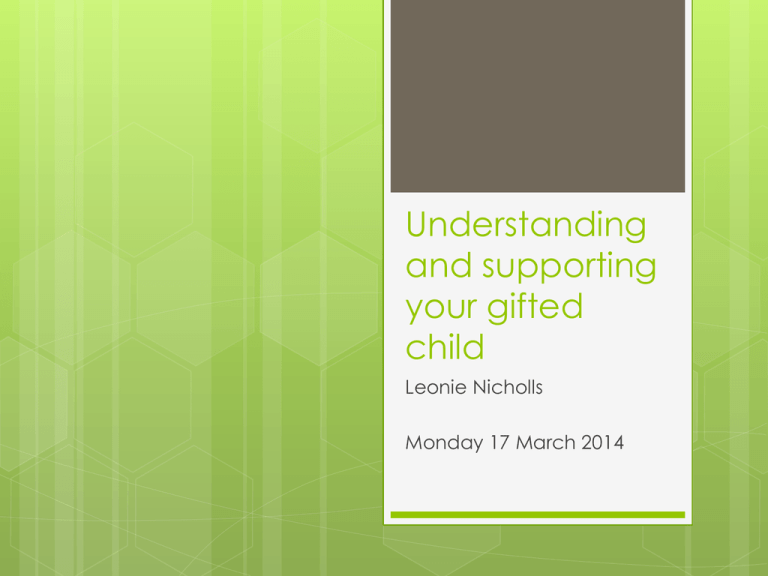
Understanding and supporting your gifted child Leonie Nicholls Monday 17 March 2014 Topics in tonight’s presentation Definitions of gifted and talented Characteristics of gifted learners Overexcitabilities Introverts and extraverts Perfectionism Underachievement Influence of parents on student achievement Giftedness and talent: What do they mean? Question: Aren’t all students gifted? Giftedness and talent: What do they mean? Everyone has a personal strength and also a personal weakness. We don’t confuse personal weaknesses with disabilities. Equally, we shouldn't confuse personal strengths with gifts. Giftedness and talent: What do they mean? Identifying a student as gifted doesn’t mean they are of greater worth than other students, just as identifying a student as developmentally disabled or physically disabled doesn’t mean they are of less worth. The Gagné Model of Giftedness and Talent Until mid-1980s, definitions of giftedness and talent used in Australia tended to be performance based. Children identified as gifted were usually the successful, motivated students who were already achieving. What about the children who had not been able to translate their high abilities into achievements? The Gagné Model of Giftedness and Talent Françoys Gagné’s model recognises and avoids this problem. ‘Giftedness’ and ‘talent’ are not synonymous. They are two different stages in a highly able student’s journey from high potential to high performance. The Gagné Model of Giftedness and Talent Gagné’s definition of giftedness: The possession of natural abilities or aptitudes at levels significantly beyond what might be expected for one’s age, in any domain of human ability. The Gagné Model of Giftedness and Talent Giftedness = high ability Talent = high achievement How does giftedness become talent? Intrapersonal catalysts: Motivation and perseverance Confidence in their abilities Organisation Concentration How does giftedness become talent? Environmental catalysts: Milieu (surroundings) Significant persons School provisions Significant family/community events Some cognitive characteristics of intellectually gifted adolescents Ability to ask reflective and probing, sometimes provocative, questions. The capacity to see and create patterns and relationships in their field of special ability. Can become deeply absorbed in work they find interesting. Some cognitive characteristics of intellectually gifted adolescents Unusually fast rate of learning. Reasons at a level more usually found in a student some years older. Extremely well developed memory. Some cognitive characteristics of intellectually gifted adolescents Dislike of slow-paced work. Many gifted students have a preference for independent work. It is unusual for a gifted student to have only one area of high ability. Some affective characteristics of intellectually gifted adolescents Emotional intensity Unusual ability to empathise with the feelings of other students or adults. An unusually well developed sense of justice and fairness. Some affective characteristics of intellectually gifted adolescents An unusually mature sense of humour. Often prefer the companionship of older students. May develop a strong attachment to one or two close friends. Some affective characteristics of intellectually gifted adolescents Students with multiple talents have difficulty deciding on a career. Some gifted students can exhibit perfectionist tendencies. For some gifted students the need to develop their gifts and feel pride in academic achievement may clash with their need to be accepted by classmates. Social comparisons Some gifted students learn, surprisingly early in their school careers, that to display abilities and opinions that are different than those of the majority of their classmates can lead to mockery and even ostracism. Some students may have been ‘dumbing down’ their abilities for years before coming to high school. Perseverance When students are presented only with work which they can do effortlessly, they may never develop skills of time management, persistence or striving for success. Some students may speed with quality. associate The forced-choice dilemma Academically gifted students may be faced with a ‘forced choice dilemma’ if their desire to excel in their area of talent conflicts with their need to be accepted by the peer culture. Can gifted adolescents be ‘over-excitable’? Tendency towards physical restlessness Often misinterpreted as a sign of emotional immaturity Overexcitability has positive connotations such as an insatiable love of learning, the capacity to care intensely for people and ideas, boundless energy, and a vivid imagination. The five ‘overexcitabilities’ Intellectual Emotional Imaginational Sensual Psychomotor Intellectual overexcitability A passionate love of learning An enhanced capacity for analytical thinking Meta-analysis (enjoys thinking about thinking) Intellectual overexcitability Sustained intellectual effort / much longer attention span Intense curiosity Unwillingness to be satisfied with simplistic or incomplete answers Emotional overexcitability Unusual sensitivity to the feelings of other students May develop a strong attachment to other people May not easily forgive themselves if they have hurt someone’s feelings Emotional overexcitability Can May be extremely self critical become fond of places, as well as people Imaginational overexcitability Explain events or ideas in such great detail that adults beg them to get to the point Often have a need to describe subtle nuances of a situation or interaction Often visualise situations very vividly Imaginational overexcitability May demonstrate a capacity to mix truth with fantasy for effect May prefer to act out stories rather than simply telling them. Sensual overexcitability Unusual sensitivity to particular pieces of music or poetry May enjoy the feel of particular materials May develop a liking for a particular object Some develop a strong dislike of the texture of particular foods even if they like the taste Psychomotor excitability Surplus energy may show itself in compulsive talking and chattering May develop nervous habits May show a love of fast games and sports Psychomotor excitability May seem almost unable to stay in their seat May have unusually rapid speech and exaggerated vocal expression Some may be seem to be workaholics or compulsive organisers Not to be confused with ADD or ADHD Experiencing ‘flow’ When a student who deeply loves what they are doing and is engaged in an activity where the level of challenge matches their level of ability, the experience can be totally absorbing and fulfilling. Csikszentmihalyi describes this feeling as being ‘in flow’ Experiencing ‘flow’ We can let ‘flow’ happen for our gifted students by presenting them with appropriate levels of challenge. Flow comes from optimal engagement with a task. It doesn’t come from doing, yet again, what one has been able to do for weeks, or months, or years. Introverts and Extraverts Introverts gain energy from within themselves; they tend to be reflective people who are ‘oriented towards the subjective world of thoughts and concepts’ (Silverman). Extraverts are more directed towards the world outside themselves and gain energy from other people or events. Introverts and Extraverts Introverts constitute a minority group in western societies (approximately 25% of the population). Studies of gifted adolescents and adults have found a much higher proportion of introverts. Gallagher (1990) studied more than 1,700 adolescents in programs for the gifted and found that 50% were introverted. Responding to the needs of introverts Give ‘wait time’ Don’t interrupt them Don’t embarrass them in public Reprimand publicly them privately rather than Responding to the needs of introverts Let them observe in new situations Develop an ‘early warning’ system Don’t push them to make lots of friends Don’t try to make them into extraverts Perfectionism The gifted adolescent’s intellectual and emotional characteristics are intertwined and closely influence each other. The personality trait of perfectionism is also influenced by factors in the young person’s environment and that this will influence whether the perfectionism is manifested in healthy or dysfunctional ways. Strategies to help perfectionists Talk to your adolescent about what perfectionism means to them - and to you. Is perfectionism a personality trait that you can recognise in yourself as well as in your child? Help to model appropriate responses. Point out positive but imperfect role models in the media Strategies to help perfectionists Learn to set priorities in your own life and help your child to do likewise. Help him or her to accept that making mistakes is a learning experience. Model your own acceptance of your mistakes. Teach the concept of ‘constructive failure’ Help your adolescent to set high but realistic standards for himself/herself but not to expect other students to conform to these same standards. Strategies to help perfectionists Help them to understand that time, effort and not giving up will help them attain the standards they are setting – if these standards are indeed realistic. Work with your gifted adolescent to improve his or her self-evaluation skills. Avoid comparing your gifted adolescent to siblings or peers. Strategies to help perfectionists Support, nurture and encourage your adolescent in activities in areas of interest or passion which bring them enjoyment. Teach your adolescent that health is important. Don’t let study interfere with eating and sleeping. Seek professional counselling if your gifted adolescent becomes so fearful of failure or rejection that s/he becomes unable to act or make decisions. Underachievement Underachievement is widely recognised as a substantial discrepancy between potential and performance Gagné’s model clearly conceptualises underachievement Important factors that inhibit the development of gifts Low academic self efficacy Forced choice dilemma Double-labelled Perfectionism students Important factors that inhibit the development of gifts Boredom Dominant visual-spatial learners Metacognition and cognitive inefficiency Teacher expectations Research strongly supports the view that high teacher expectations can positively influence student academic achievement (especially for underachieving students) Conversely, if a teacher holds expectations for students, then negative impact may be substantial. low the Profiles of gifted and talented students Created Are by Betts and Neihart useful for understanding gifted underachievers Type 1: Successful Well behaved, conformist, seeks approval from teachers and adults Neat, tidy, may be perfectionist Seeks order and structure Does not take risks Achieves, but at levels significantly below their true ability Type 2: Challenging Can be obstinate, tactless, sarcastic Questions and challenges authority Can be rude, arrogant Unpopular with peers but sometimes buys acceptance as class clown Does not ‘suffer fools gladly’ Type 1 and Type 2 Type 2 students may be bored, angry and resentful that their abilities are not recognised and may ‘take it out’ on their teachers and other students. Unfortunately this decreases the likelihood of them being identified as gifted by teachers who associate giftedness with Type 1 behaviours Type 3: Underground Conceals Strong ability for peer acceptance belonging needs May be insecure and anxious May feel guilty for denying their gifts Type 4: Dropouts May be physically present in the classroom but intellectually/emotionally divorced from what is going on in it Can be depressed and withdrawn or angry and defensive Type 4: Dropouts Interests may lie outside curriculum and are not valued by teachers or classmates Extremely performance low self-esteem; low Type 5: Double labelled (twice exceptional) Gifted students who are physically or emotionally disabled or with specific learning disabilities May display disruptive behaviours through frustration Type 5: Double labelled (twice exceptional) May be confused about their ability to perform Very frustrated when teachers ignore their gifts and focus only on their disabilities Type 6: Autonomous learners They They use the system to succeed are confident enough to express their needs but do so in ways that teachers and peers will accept Type 6: Autonomous Independent They them They and self-directed don’t wait for others to do things for are liked and respected by teachers and peers Type 6: Autonomous All gifted students should be assisted to become autonomous learners Influence of parents Studies of young people who grew up to be highly successful in their careers have found that the messages transmitted by their parents had a lot in common. Their parents: placed strong emphasis on trying to do one’s best, working hard and spending one’s time constructively. emphasised the importance of study, learning and school. Influence of parents taught respect for individuality and tolerance for the points of view of others. recognised a balance of work and play. provided a balance of support and challenge. provided predictable and consistent expectations for conduct. Thank you Any further questions or comments on tonight’s presentation: Leonie.Nicholls@education.wa.edu.au
